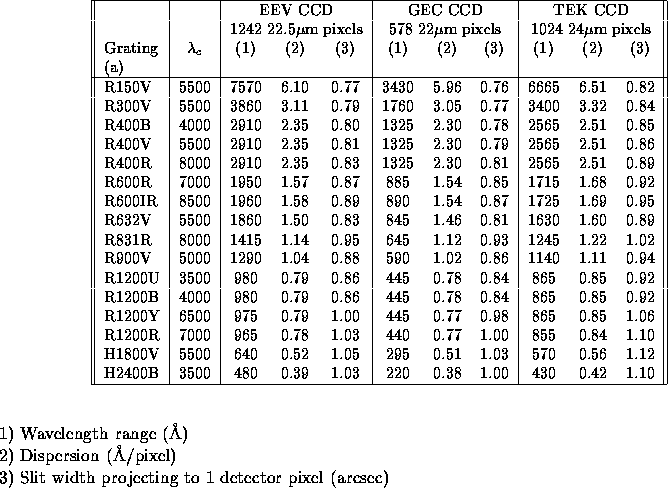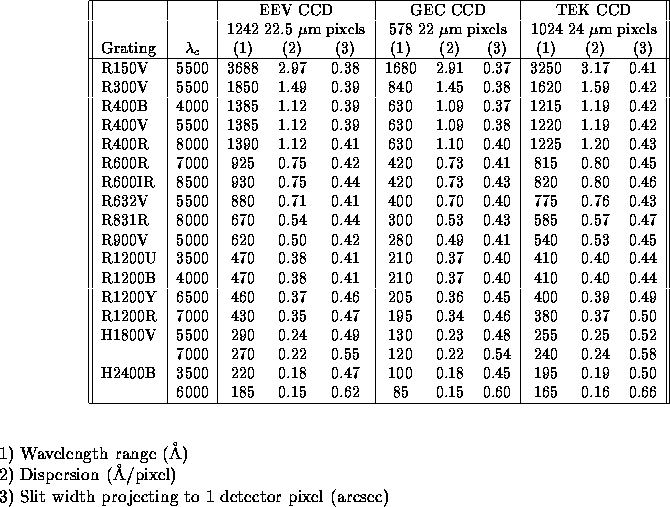



Next: Stability
Up: Performance
Previous: Performance
Tables  and
and  gives for each CCD/camera/grating configuration the wavelength range, the dispersion in
Å/pixel, and the slit width projecting to one pixel at the detector.
With the exception of the 1800 and 2400 lines/mm gratings, the wavelength
coverage does not significantly vary with the central wavelength.
For proper sampling, the wavelength resolution cannot be less than about 2
pixels. In general a slit width should be used which projects to about 2 pixels
at the detector. If a wider slit is used to increase the total throughput of
the instrument, the wavelength resolution will be degraded.
gives for each CCD/camera/grating configuration the wavelength range, the dispersion in
Å/pixel, and the slit width projecting to one pixel at the detector.
With the exception of the 1800 and 2400 lines/mm gratings, the wavelength
coverage does not significantly vary with the central wavelength.
For proper sampling, the wavelength resolution cannot be less than about 2
pixels. In general a slit width should be used which projects to about 2 pixels
at the detector. If a wider slit is used to increase the total throughput of
the instrument, the wavelength resolution will be degraded.
It is normal for gratings to be installed with the blaze directed towards
the collimator.
It is worth noting is that if a grating were to be mounted with the wrong
orientation, with the blaze directed towards the camera, there would be a
dramatic decrease of throughput. In the case of the holographic 2400B grating,
however, the dispersion will be affected too, and, in fact, a resolution
improvement of about 20% can be obtained at high anamorphic magnification, but
only at the cost of a drastic loss of efficiency.

Table: IDS Wavelength range and resolution (235 mm camera)

Table: IDS Wavelength range and resolution (500mm camera)
Tue Aug 15 16:42:46 BST 1995
 and
and  gives for each CCD/camera/grating configuration the wavelength range, the dispersion in
Å/pixel, and the slit width projecting to one pixel at the detector.
With the exception of the 1800 and 2400 lines/mm gratings, the wavelength
coverage does not significantly vary with the central wavelength.
For proper sampling, the wavelength resolution cannot be less than about 2
pixels. In general a slit width should be used which projects to about 2 pixels
at the detector. If a wider slit is used to increase the total throughput of
the instrument, the wavelength resolution will be degraded.
gives for each CCD/camera/grating configuration the wavelength range, the dispersion in
Å/pixel, and the slit width projecting to one pixel at the detector.
With the exception of the 1800 and 2400 lines/mm gratings, the wavelength
coverage does not significantly vary with the central wavelength.
For proper sampling, the wavelength resolution cannot be less than about 2
pixels. In general a slit width should be used which projects to about 2 pixels
at the detector. If a wider slit is used to increase the total throughput of
the instrument, the wavelength resolution will be degraded.





